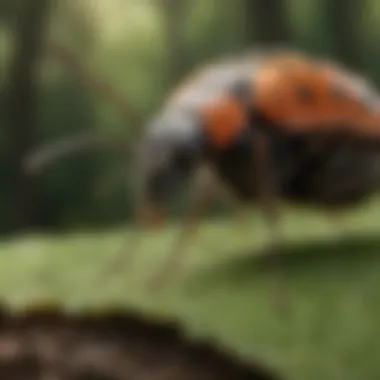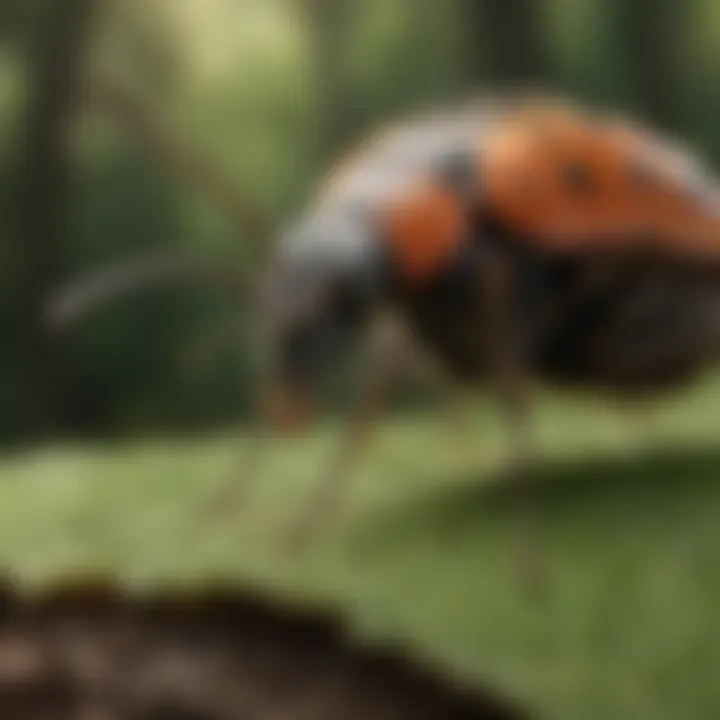Motherlode Pest Control: Ecosystem Management Strategies


Intro
Pest control is a crucial aspect of maintaining healthy woodland ecosystems, particularly in diverse regions like the Motherlode. This article is designed for forestry professionals and academics who seek to understand the intricate relationship between pest management, biodiversity, and ecosystem health. By exploring sustainable practices, readers will gain insight into how integrated pest management can benefit both the environment and the community.
Understanding Woodland Ecosystems
Woodland ecosystems are complex networks of living organisms and their physical environment, contributing to the overall health of our planet. In this section, we explore two essential components of these ecosystems: biodiversity and climate regulation.
Importance of Biodiversity in Forests
Biodiversity refers to the variety of life forms in a given environment. In forests, this includes a wide range of flora and fauna, each playing a unique role in maintaining ecological balance. Healthy biodiversity supports resilience against pests, diseases, and climate change impacts.
- Enhanced Stability: Forests with high biodiversity are less susceptible to invasive species, as the native species can often outcompete these threats.
- Ecosystem Services: Diverse ecosystems provide various services, including pollination of plants, water regulation, and carbon sequestration.
Understanding these dynamics is pivotal for implementing effective pest control measures that do not compromise biodiversity.
Role of Forests in Climate Regulation
Forests act as vital regulators of the climate, absorbing carbon dioxide and releasing oxygen. They influence local weather patterns and contribute to cooling the atmosphere.
- Carbon Sequestration: Trees capture and store carbon, which helps mitigate climate change.
- Water Cycle Maintenance: Forest canopies intercept rainfall and regulate water flow, further sustaining local ecosystems.
Collectively, these functions underscore the necessity of a thoughtful approach to pest management that aligns with preserving both biodiversity and climate integrity.
Sustainable Forestry Practices
Sustainable forestry practices aim to meet current needs without compromising future generations' ability to benefit from forest resources. This section discusses principles and examples of these practices in action.
Principles of Sustainable Forestry
Sustainable forestry focuses on multiple principles that guide forest management:
- Choose Wisely: Selecting the appropriate species for cultivation helps ensure ecological compatibility.
- Maintain Continuity: Practices must promote long-term health rather than short-term profit.
- Community Engagement: Involving local communities fosters stewardship and strengthens conservation efforts.
Case Studies of Successful Implementations
Examples of successful sustainable forestry practices are pivotal for understanding their real-world applications. For instance, the efforts in the Sierra Nevada region showcase how adaptive management approaches can enhance ecosystem resilience. Through selective logging and habitat restoration, biodiversity has improved while ensuring local communities benefit economically.
Woodland Stewardship Techniques
To ensure the health of woodland ecosystems, stewardship techniques are vital. These techniques focus on structured management plans and conservation strategies.
Forest Management Plans
A forest management plan serves as a roadmap for maintaining the ecological integrity of a woodland area. Key elements of such plans include:
- Assessing Forest Health: Regular evaluations help identify pest outbreaks and other threats.
- Setting Objectives: Clear goals guide management actions harmonizing ecological sustainability and community needs.
Conservation Strategies
Conservation strategies complement management plans by focusing on protecting vulnerable species and habitats. Techniques may involve:
- Creating Buffer Zones: These zones serve as protective areas around sensitive ecosystems.
- Restoration Projects: Rehabilitating degraded areas promotes biodiversity recovery.
Effective implementation of these stewardship techniques can significantly contribute to pest control efforts, ultimately benefiting woodland health and sustainability.
"Integrated pest management is not just about eliminating pests; it's about finding a balance that nurtures the ecosystem."
Prolusion to Motherlode Pest Control
Understanding pest control in the Motherlode region is crucial for maintaining the delicate balance of its woodland ecosystems. This section introduces the fundamentals of pest management and the unique challenges faced in this area. Various factors impact pest populations and their interactions within the ecosystem. Therefore, a comprehensive approach, integrating various strategies, is necessary.
In this article, we explore how effective pest control can promote biodiversity and sustainable forest health. The importance of this lies not only in economic benefits but also in ensuring a resilient ecosystem. As pest populations can vary dramatically, adapting management practices to the specific needs of the Motherlode region becomes vital. By doing so, we can mitigate damage caused by invasive species and maintain the natural order of native species.
Efficiency in pest management involves a partnership with local communities, which enhances the understanding of pest behaviors and the ecological implications of their control. Education in sustainable practices is necessary, as both professionals and enthusiasts must work together for the health of their woodlands.


Understanding the Motherlode Region
The Motherlode region, renowned for its rich history and diverse ecosystems, presents unique environmental conditions that influence pest dynamics. Its varied landscapes include dense forests, meadows, and water bodies. This diversity supports a wide range of plant and animal life, creating habitats for numerous pests, both beneficial and harmful. Elevation, soil types, and climate variability further contribute to the intricate balance of this ecosystem.
Local pests may include herbivores that feed on vegetation and thus can impact overall plant health. Predators and decomposers also play roles in maintaining ecological balance; however, an overpopulation of any single group can lead to adverse effects. Therefore, understanding these interactions within the Motherlode is necessary for implementing successful pest control measures.
The Importance of Pest Control in Woodlands
Pest control is a vital component of woodland management. It directly affects the health of trees and undergrowth, ensuring the availability of resources for native species and future generations. Without proper pest management, invasive species can outcompete local flora and fauna, leading to decreased biodiversity.
In woodlands, balancing pest populations is essential. Conservationists and forestry professionals aim to maintain the integrity of these ecosystems. The following points highlight the importance of pest control in woodland areas:
- Biodiversity Preservation: Effective pest management protects native species, which contribute to diverse ecosystems.
- Ecosystem Health: Healthy pest populations support nutrient cycling, plant growth, and soil health.
- Resource Management: Sustainable pest control helps secure the sustainability of timber and non-timber forest products.
"Without proper management, pests can disrupt the balance of woodland ecosystems, leading to long-term ecological damage."
In summary, pest control in the Motherlode region is not just about the elimination of harmful pests. It is about managing the ecosystem holistically to preserve the intricate web of life that exists there.
Ecological Overview of Pests
Understanding pests within the ecology of an ecosystem is essential for effective pest management. Pests are often perceived solely as threats to crops or forest health. However, they play intricate roles in maintaining ecological balance. An ecological overview of pests helps frame these organisms within their natural context, allowing us to appreciate their roles and contributions. Recognizing that not all pests are inherently harmful is pivotal in fostering a sustainable approach to ecosystem management, particularly within the Motherlode region.
Types of Pests and Their Natural Roles
Herbivores
Herbivores are an integral aspect of the ecosystem. They feed on plants, helping to manage vegetation growth. This grazing activity can stimulate new plant growth, promoting biodiversity. Furthermore, herbivores often serve as food sources for predators, creating a balanced food web.
A key characteristic of herbivores is their preference for specific plant types. This selectivity can benefit the ecosystem by preventing any one species from becoming overly dominant. However, it can also lead to overgrazing, which poses challenges for regeneration. In this article, recognizing the dual nature of herbivores helps articulate their overall importance.
Predators
Predators hold a crucial position in regulating pest populations. They help control the number of herbivores and other pests, preventing any population from overwhelming the system. This predation keeps ecosystem dynamics in check, promoting stability within the Motherlode woodlands.
The strong characteristic of predators is their reactive nature; they often adapt rapidly to changes in their prey populations. This adaptability makes them effective allies in pest control. However, habitat loss and changes in pest populations can hamper predator effectiveness. Understanding these dynamics is key for sustainable ecosystem management.
Decomposers
Decomposers, including fungi and bacteria, play an essential role in nutrient cycling. They break down dead organic matter, returning vital nutrients back to the soil. Without decomposers, ecosystems would quickly become overwhelmed with dead materials, inhibiting new growth.
A key feature of decomposers is their ability to transform substances that are otherwise indigestible to most organisms. Their work ensures that energy flows through the ecosystem effectively. However, the role of decomposers is often overlooked in pest management discussions, even though they significantly influence overall ecosystem health.
Ecosystem Dynamics and Pest Populations
Pest populations are influenced by various ecological factors, including food availability, habitat suitability, and population dynamics of predators and competitors. Changes in one of these elements can lead to fluctuations in pest numbers and types.
For instance, an increase in herbivores may create more feed for predatory species, which will subsequently increase their numbers. Conversely, pesticide use or habitat alterations can disrupt these dynamics, leading to pest outbreaks. A deep understanding of these interactions is essential for sustainable pest management strategies in the Motherlode region.
Integrated Pest Management (IPM) Principles
Integrated Pest Management, or IPM, is essential in addressing pest issues within the Motherlode region. This approach examines the myriad factors that contribute to pest populations and their impacts on the ecosystem. By utilizing a combination of methods, IPM aims to manage pests in a way that is both economically viable and environmentally sensitive. This principle recognizes that complete pest eradication is often not practical and instead focuses on maintaining pest populations at tolerable levels. The overarching goal of IPM is to foster a balance between the organisms within the ecosystem and the impact of pest species.
What is Integrated Pest Management?
Integrated Pest Management is a strategic approach to pest control that integrates various management tactics. Its foundation lies in understanding pest biology and ecology. This system includes biological, cultural, mechanical, and chemical control methods. The importance of IPM arises from its holistic nature; it does not rely solely on chemical pesticides but seeks to understand and mitigate the conditions that allow pests to thrive. This makes it a more sustainable model for pest management, which can be especially beneficial for the fragile woodlands in the Motherlode region.
Steps in Developing an IPM Plan
Developing an effective IPM plan involves several key steps that ensure comprehensive pest management strategies.
Assessment
Assessment is the first step in an IPM plan, focusing on identifying pest issues, determining their severity, and evaluating their impact on the ecosystem. This phase is critical as it sets the foundation for all subsequent actions. The key characteristic of assessment in IPM is its thoroughness—professionals collect data regarding pest populations and their behaviors. This systematic approach makes assessment a beneficial choice for targeted pest management. The unique feature of assessment lies in its adaptability; it can evolve based on new findings or changes in the ecosystem. The advantages include tailored approaches to specific pest issues, though it can be time-consuming.
Monitoring
Monitoring follows assessment and involves ongoing observation of pest populations and their environments. This specific aspect allows managers to track changes and identify trends over time. The key characteristic of monitoring is its continuous nature, as it promotes proactive rather than reactive strategies. Monitoring is a popular choice in IPM because it enables quick identification of pest outbreaks before they become severe. Its unique feature is the ability to integrate technology, such as traps and sensors, to collect data efficiently. While it increases precision in management decisions, it requires consistent attention and can incur costs.


Control Techniques
Control techniques encompass a range of strategies designed to keep pest populations at manageable levels. This aspect of IPM focuses on multiple methods, including biological, cultural, physical, and sometimes chemical controls. The key characteristic of these techniques is their diverse application; each method can be adjusted based on specific pest types and ecosystem dynamics. This versatility makes control techniques a crucial component of IPM. The unique feature of employing various control techniques is that it reduces reliance on any single method, thereby minimizing potential negative effects. While these methods can be beneficial for long-term sustainability, the challenge lies in the need for educated implementation to ensure effectiveness without harming the ecosystem.
By integrating these principles, IPM can enhance pest control efficacy while preserving the integrity of the Motherlode region's environment.
Sustainable Pest Control Techniques
Sustainable pest control techniques are pivotal in managing pest populations while preserving ecosystem integrity. These methods not only limit pest outbreaks but also promote biodiversity and ecological balance. The main benefits of sustainable techniques include reduced chemical reliance, safer environments for non-target species, and long-term pest management efficiency. Considerations such as local ecological impact and the adaptability of techniques are essential for successful implementation.
Biological Control Methods
Use of Natural Predators
Utilizing natural predators is an effective biological control method that leverages the natural food web to manage pest populations. This approach involves the introduction or enhancement of species that prey on pests, thus keeping their numbers in check. The key characteristic of this method is its focus on ecological principles, which result in a more sustainable form of pest control. It is beneficial as it minimizes the need for chemical pesticides, which can have deleterious effects on biodiversity. However, there are challenges, such as ensuring that introduced predators do not themselves become invasive, which could disrupt local ecosystems.
Beneficial Insects
Beneficial insects play a crucial role in sustainable pest control by acting as natural enemies to harmful pests. Examples include ladybugs and lacewings, which consume aphids and other pests. The key characteristic of beneficial insects is their ability to maintain a balance in pest populations naturally. They are popular in sustainable management practices due to their effectiveness and accuracy in targeting specific pests. Nonetheless, their population dynamics can be affected by environmental conditions, leading to fluctuations in their efficacy.
Cultural Practices for Pest Management
Crop Rotation
Crop rotation is an agricultural practice that involves alternating the types of crops grown in a particular area over time. This technique reduces pest buildup by disrupting their life cycles and creating a less favorable environment for them. The primary benefit of crop rotation is its ability to improve soil health while reducing pest infestations, making it a beneficial choice for sustainable management. However, careful planning is required to avoid potential crop conflicts that could lead to reduced yields.
Habitat Manipulation
Habitat manipulation involves changing the environment to favor pest control by enhancing conditions for beneficial organisms while limiting those for pests. This can include altering plant arrangements or managing moisture levels. The key characteristic of habitat manipulation is its proactive nature, as it aims to guard against pest establishment before they cause harm. This method is advantageous, as it can lead to long-term pest suppression. Nonetheless, it requires knowledge of local ecology to implement effectively, which can pose a challenge for some practitioners.
Mechanical and Physical Controls
Traps
Traps are simple yet effective mechanical control tools designed to capture or kill pests. They can range from handmade versions to commercially available models, including sticky traps and pheromone traps. The key characteristic of traps is their low environmental impact compared to chemical controls. They provide a focused method of pest control that can greatly assist in monitoring pest populations. However, traps must be maintained regularly to ensure efficacy, and some may not be suitable for all pest types.
Barriers
Barriers serve as physical obstructions to prevent pest entry into certain areas, such as gardens or fields. This method can include using nets, fences, or row covers to safeguard crops from pests. The primary advantage of barriers is their straightforward application and effectiveness in controlling pest access. However, barriers must be carefully designed to ensure they do not inadvertently shelter pests or limit beneficial species, which requires constant monitoring and adjustment.
Sustainable pest control techniques require ongoing efforts and local ecological knowledge for successful implementation, highlighting the need for community involvement and education.
Chemical Control: A Last Resort?
Chemical control often emerges as a necessary discussion point in pest management strategies, especially in the complex ecology of the Motherlode region. Using chemical pesticides can be an effective method to manage pest populations when other approaches have not yielded the desired outcomes. However, this approach comes with particular concerns that must be addressed in order to promote sustainable practices. It practices the principle of reacting to widespread pest infestations that could otherwise disrupt the delicate balance within the ecosystem. The key is to understand when it is appropriate to resort to chemical methods while weighing the potential implications for both the environment and human health.
Types of Pesticides and Their Effects
Pesticides can be categorized into several main types, each having specific modes of action and targeting different kinds of pests. Understanding these types is crucial for making informed decisions about their use.
- Insecticides are effective against insects and can function as neurotoxins or stomach poisons.
- Herbicides target unwanted plant species, aiming to control or eliminate them without harming the desired flora.
- Fungicides fight fungal infections, which can devastate crops and woodland plants.
The effects of these chemicals can vary significantly, depending on their formulation. Some pesticides act quickly, causing immediate mortality, while others may take longer to show results but have prolonged effects. Non-target organisms can also be affected, leading to unintended consequences in biodiversity.
Risks of Chemical Applications
Environmental Impact
The environmental impact of chemical pesticides is a critical aspect of their discussion. These substances can directly affect non-target organisms, including beneficial insects, aquatic life, and soil microorganisms. The key characteristic of this impact is the potential for bioaccumulation, where chemicals build up in the food chain, affecting higher trophic levels. This situation could lead to a decrease in biodiversity, disrupting ecosystem services that are vital for woodland health.
One significant unique feature of this environmental impact is the risk of water contamination. Runoff from treated areas can introduce pesticides into nearby streams and rivers, thus affecting aquatic ecosystems and drinking water supplies. This aspect poses disadvantages for both ecological integrity and public well-being, underlining the necessity for restraint when using chemical pesticides.
Human Health Concerns
Human health concerns linked to chemical pesticide use also warrant significant attention. Exposure to these chemicals can occur through inhalation, skin contact, or ingestion. The key characteristic of human health concerns is the variety of potential effects, ranging from short-term symptoms like headaches to chronic conditions that can emerge after long-term exposure. These varying impacts make it essential to prioritize human safety in pest management practices.


One critical unique element is the discussion around developmental and reproductive effects. Some studies suggest that certain pesticides may disrupt endocrine function, leading to long-lasting health problems. This characteristic amplifies the consideration surrounding the use of chemicals in pest control. Ultimately, the challenges posed by health risks highlight the importance of taking a cautious approach when resorting to chemical controls in pest management.
Community Involvement in Pest Control
Community involvement plays a critical role in effective pest control strategies, especially in regions like Motherlode. Engaging local residents and stakeholders fosters a sense of shared responsibility and encourages sustainable practices that align with ecosystem management goals. When communities participate actively, they become more attuned to the challenges and solutions associated with pest control, which leads to better outcomes.
One of the benefits of community involvement is the pooling of knowledge and resources. Local residents often have invaluable insight into the behaviors and patterns of pests in their area. Using this information can enhance pest management efforts significantly. Additionally, when community members are educated about the implications of pest proliferation, they can take proactive measures to mitigate risks.
Moreover, community participation fosters collaboration among various stakeholders, including local governments, non-profit organizations, and professional pest management services. This collaboration can lead to more comprehensive solutions, as each party brings unique expertise and resources to the table. The overall approach becomes more effective when communities unite in their efforts to manage pest populations sustainably.
"Community engagement does not just improve pest control; it builds a culture of stewardship and environmental ethics that benefits all aspects of ecosystem health."
Educational Programs and Workshops
Educational programs are foundational for building awareness about pest control practices. Workshops can serve as platforms for training community members about integrated pest management techniques. They can cover a wide range of topics, such as recognizing pest species, understanding their life cycles, and exploring methods of control that are both effective and environmentally friendly.
Hands-on workshops can be particularly beneficial. Participants can learn about the proper use of various control methods, such as traps and barriers, and understand when to seek help from professionals. Additionally, these programs can provide instruction on cultural practices like crop rotation and habitat manipulation. This knowledge empowers community members to take an active role in managing pests effectively.
Volunteer Opportunities in Pest Management
The presence of volunteer opportunities can significantly enhance pest control initiatives within communities. Volunteers can assist in various capacities such as monitoring pest populations, conducting habitat assessments, or participating in cleanup events that reduce pest breeding grounds. The hands-on involvement not only aids pest control efforts but also builds community cohesion.
Also, volunteering allows individuals to gain practical experience and contribute to their environmental well-being. Local organizations often facilitate these volunteer opportunities, providing guidance and support. When individuals engage in volunteer work, they become ambassadors for responsible pest management practices, spreading knowledge and awareness within their social circles.
By highlighting the importance of community engagement, it becomes clear that local efforts are indispensable in the fight against pest-related challenges. Few approaches are as effective and rewarding as working collaboratively towards shared environmental goals.
Monitoring and Evaluating Pest Control Success
Monitoring and evaluating pest control success is crucial in maintaining the delicate balance of ecosystems, particularly in the Motherlode region. This process ensures that pest management strategies are effective and sustainable. By systematically assessing the outcomes of pest control measures, land managers and forestry professionals can make informed decisions that benefit both the environment and community health.
Effective monitoring encompasses a range of activities including regular inspections, data collection, and analysis. These steps help identify pest populations, their impacts, and the effectiveness of the control measures implemented. The information gathered through monitoring provides insight into the ecological interactions at play, helping professionals understand how pest populations affect woodland health.
Key Performance Indicators (KPIs) in Pest Management
Key Performance Indicators (KPIs) serve as a quantitative measure to gauge the success of pest management strategies. These indicators help in evaluating the impacts of interventions on both pest populations and the overall health of the ecosystem. Some vital KPIs include:
- Pest Population Density: Tracking changes in pest numbers can reveal the effectiveness of control methods.
- Biodiversity Levels: A decrease in pest populations should correspond with stable or increased levels of native species, indicating a healthy ecosystem.
- Economic Impact: Evaluating costs versus benefits of pest management will inform decisions on resource allocation.
Regularly reviewing these KPIs enables forest managers to adjust their strategies, ensuring a proactive approach to pest control.
Adjusting Strategies Based on Results
Based on the insights gained from monitoring, adjustments to pest management strategies may be necessary. This adaptability is key to addressing the evolving dynamics of pest populations and the ecosystem.
When results show sustained high levels of pest populations, it may indicate that current strategies are insufficient. In such cases, the following steps could be taken:
- Reassess Control Methods: Evaluate whether the existing approaches—be they biological, cultural, or chemical—are suitable or require modification.
- Increase Monitoring Frequency: Intensifying monitoring efforts may provide a clearer picture of pest dynamics and inform on effective responses.
- Engage with Community: Involving local stakeholders can enhance efforts, as they might offer valuable insights or assist in monitoring tasks.
Adapting strategies based on evaluations is not merely a reactive measure but also a proactive step towards sustainable pest management. By being responsive to the findings, forest managers can ensure that pest control efforts align more closely with ecological goals, ultimately leading to healthier woodlands.
"Sustainable pest control requires ongoing vigilance and adaptation to changing conditions."
Future Trends in Pest Control
Pest control is an evolving field, and understanding future trends is essential for any ecosystem management strategy. As we look forward, several key factors impact our approach to pest control. These factors include the integration of technology, changing policies, and growing awareness of sustainability in pest management.
Technological Advances in Pest Management
Technology's role in pest management has increased significantly in recent years. Advances in data collection and analysis improve how we monitor pest populations. Technologies like remote sensing and drones provide valuable data about pest distribution and behavior. These tools help in assessing pest impacts more accurately and efficiently.
Furthermore, biotechnology is playing a role in developing targeted pest control products. For instance, genetic engineering allows for the creation of pest-resistant plant varieties. Through these innovations, we can reduce the reliance on chemical pesticides, which often have broader ecological impacts.
With data analytics, pest control professionals can implement more precise management practices. Analysis of large datasets enables tailored control strategies that consider location, pest species, and seasonal changes. Using integrated pest management techniques combined with technology can lead to improved outcomes and reduced ecological footprints.
"Technology will not only enhance the effectiveness of pest management, but also reduce its environmental footprint."
Policy Changes and Their Implications
As society grows more aware of ecological issues, policy changes become crucial in shaping pest management strategies. Regulatory frameworks are evolving to emphasize sustainability and environmental protection. Policies that encourage biological control methods and restrict harmful chemicals are becoming more common.
These changes can foster innovative practices in pest management. For example, policies supporting organic farming often promote integrated pest management approaches. This leads to healthier ecosystems and enhances biodiversity. Additionally, public funding for research in sustainable practices is crucial. It can help develop new methods for pest control that are both effective and environmentally friendly.
Understanding the implications of these policy changes is vital for forestry professionals. They must adapt their strategies to align with new regulations. Such adaptations not only ensure compliance but can enhance the credibility of pest management practices in the eyes of the public.







